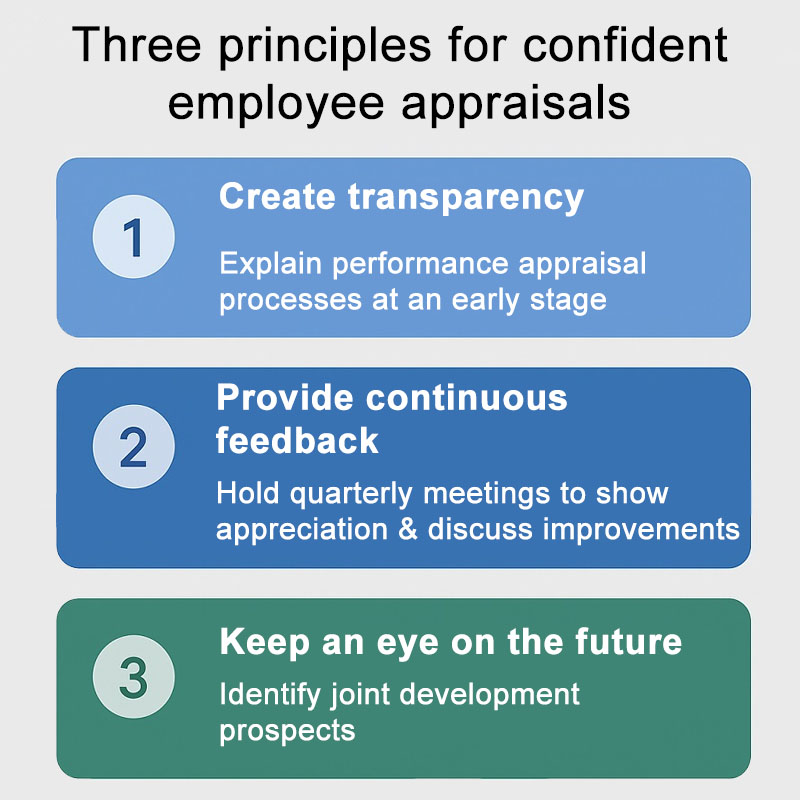Conflicts in employee appraisals
How to remain confident as a manager when a employee appraisal goes wrong
Managers don’t have it easy. In every training course, they are told that they should listen better, lead in a more employee-oriented manner and resolve conflicts as quickly as possible. But employees don’t make life easy for them either. Exceptions prove the rule. In this article, I will therefore focus explicitly on three ‘employee traps’ that you, as a manager, should no longer fall for.
By ‘employee traps’, I mean killer phrases or even manipulation techniques that can deliberately or negligently cause an appreciative employee appraisal or performance review to fail. This is the moment when you, as a manager, are left speechless because you really don’t have an answer or because the employee’s assertion may have a point. Caution is always advised in such situations. From my everyday training experience, I have brought you three situations that you can certainly relate to and that regularly cause my participants to break out in a cold sweat.
Example No. 1: ‘What do I have to do to get X% more?’
I assume that you have done your homework as a manager and that it is in your interest to maintain a stable relationship with your employee. So you have taken notes throughout the year and prepared your feedback well. [1] A combination of incorrect implementation, false assumptions and conflict avoidance forms the basis for increasing performance bonuses. [2] For many employees, this creates a consumerist attitude in which it seems almost impossible to give honest – and honest often means negative – feedback. A downgrade is hardly conceivable here and is tantamount to a personal insult.
In my practical example, you are in the middle of a conversation and your employee seems to understand and agree with your assessment, but then comes the all-important question: ‘What do I have to do to get X% more money in the next assessment?’
I regularly get this question in my training sessions and see question marks in the eyes of my participants. The problem is not so much the question itself, but the intention behind it. We should be happy when our employees want to perform better. But this aspect is ignored by the employees, who simply hold out their hands.
If you are confronted with this question, I advise you to discuss the intention behind the request for money in more detail. Why is it important to the employee to receive a higher allowance?
- Is it the appreciation that he or she otherwise does not receive from you?
- Or is it an internal competition in which your conversation partner wants to emerge as the winner?
- Perhaps it is the mortgage on their house that is keeping your employee awake at night.
Only when you understand the intention behind the statements can you steer the conversation back onto a productive track. Either because you agree on the next steps, which in the best case scenario will actually lead to a higher allowance, or because you resolve possible fears or a lack of appreciation in ways other than with money.
Example No. 2: ‘Why does A get more than me?’
My second example is based not only on personal sensitivities, but also on a forgivable lack of knowledge about remuneration. In collectively agreed remuneration structures, jobs are assigned to a remuneration group. The higher the group, the higher the value of the work and thus the wage. [3] This fact must be taken into account when assessing performance, because it has two consequences:
- Only employees in the same pay group are comparable, and
- Expectations are higher for higher groups.
It is therefore simply not possible to compare employees with others, even if they appear to be doing the same job. In addition, performance assessments always remain subjective evaluations of performance, lacking clear benchmarks such as a specific number of units produced. Performance assessments are about diligence, effectiveness, setting priorities and persuasiveness. Everyone involved must live with this dilemma and learn to deal with it.
If you find yourself in such a situation, explain the system mentioned above to your employee and clarify the different expectations. Work closely with your employees on your relationship throughout the year and repeatedly address the performance aspect. At the same time, you should make the effort to assess performance concretely and to the best of your knowledge and belief. In the last article, I talked about assessment errors [4], which also includes the fact that all criteria should be assessed independently of each other.
Here, too, the intentions of the employees play a special role, because you should know what motivates your employees, what is important to them and what personal aspects drive them crazy. For performance appraisal, this means that a poorly rated characteristic does not mean that all other characteristics must also be rated poorly. The criteria are independent of each other. An essential part of appreciation is to highlight the small but subtle differences between employees A and B.
Example No. 3: ‘Only with maximum points did I perform well.’
The question about my last example can be answered succinctly with ‘no.’ If it were always that simple, we wouldn’t need this article. So I’ll give you a glimpse behind the scenes of the system and its pitfalls. Performance appraisal in the remuneration framework agreement takes place on five levels.
The middle level determines that the employee fulfils their work to the full extent. In other words, they do what you ask them to do. Fun fact: the system already provides for a bonus for this alone. However, managers often have an issue with this because employees cannot understand this fact. The middle is not a bad performance. It already rewards your employees for doing their job.
For some people, however, only the full score counts, which would mean that their performance exceeds the requirements to a particular extent. I know that you will have one or two candidates in your team who will explain to you in detail that their performance is just as special. However, the reality is often different.
To avoid getting into such a situation, it is a good idea to explain the system in more detail in the run-up to the assessment. Your HR staff will certainly be able to help you with this. Even during the interview, you should explain this detail again and again so that it is not forgotten. In this context, one aspect is often overlooked, namely the question: Does this position actually require exceptional performance? This brings me back to the objectives of an assessment and the associated employee interview.
Take the opportunity to talk to your employee about their future development:
- Where does the employee see themselves in five years?
- How do they feel about career advancement?
- What projects would they like to take on?
Here, too, it is very important to understand exactly what your employees want. This will enable you, as a manager, to support them very effectively.
Conclusion: How to respond confidently to difficult situations in employee appraisals
The three ‘employee sticks’ described above are just a small sample of what you may encounter in your day-to-day management work. Anyone who has been responsible for personnel for a long time knows that appraisal situations rarely go according to plan. Therefore, it is less important to have the perfect answer to every killer phrase. Many conflicts arise from a lack of transparency, for example. You should therefore explain as early as possible how performance appraisals work, what criteria apply and what scope there is for decision-making. If employees can understand the process, they are less likely to feel that they are being treated unfairly.
Taking notes throughout the year is a good start, but continuous observation and feedback are really helpful. Schedule short, quarterly feedback meetings in which you address both praise and potential for improvement. This prevents dissatisfaction from building up and escalating during the official annual review. It also gives you a clearer picture of what development steps are realistic.
A performance review is not just a review of the past, but also a look ahead to the future. Therefore, keep focusing on the shared future: What qualifications could enable the next career step? Which projects offer room for responsibility? This gives employees a goal that goes beyond monetary incentives and at the same time strengthens their loyalty to the company. [5]
Figure: Three principles of confident employee appraisals
Notes (partly in German):
Would you like to improve cooperation within your team or your communication skills as a manager? Then visit the website of Michael Zocholl and arrange a consultation. It’s definitely worth it!
By the way: You can also find an interesting podcast episode in German on the topic on the website: Z wie Ziele – Vorhaben klar und messbar definieren.
[1] Michael Zocholl: 3 myths that ruin your employee appraisal
[2] I.M.U – Institut für Mitbestimmung und Unternehmensfuehrung: Leistung und Lohn im ERA-Tarifvertrag NRW
[3] Hartmut Klein-Schneider: Leistungs- und erfolgsorientiertes Engelt. Analyse und Handlungsempfehlungen.
[4] Michael Zocholl: The art of performance appraisal
[5] Personio: Beispiele für konkrete Zielvereinbarungen
Michael Zocholl has published two more articles on the t2informatik Blog:

Michael Zocholl
Michael Zocholl is a business psychologist who supports managers and teams in strengthening communication, cooperation and trust in the long term – through workshops, coaching and training. In his podcast Zuhören, Fragen, Führen (Listen, Ask, Lead), he addresses the challenges and opportunities surrounding employee appraisals once a week. Conclusion
In the t2informatik Blog, we publish articles for people in organisations. For these people, we develop and modernise software. Pragmatic. ✔️ Personal. ✔️ Professional. ✔️ Click here to find out more.


